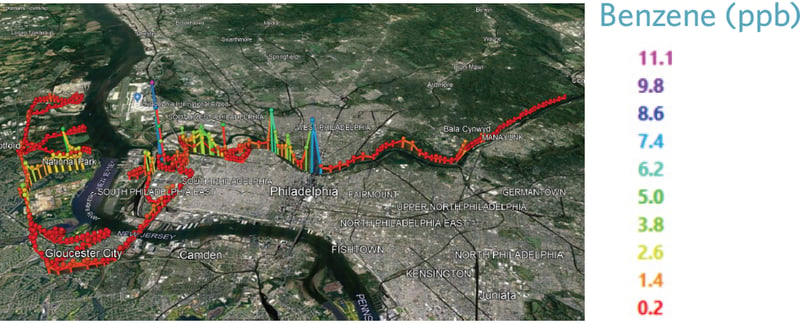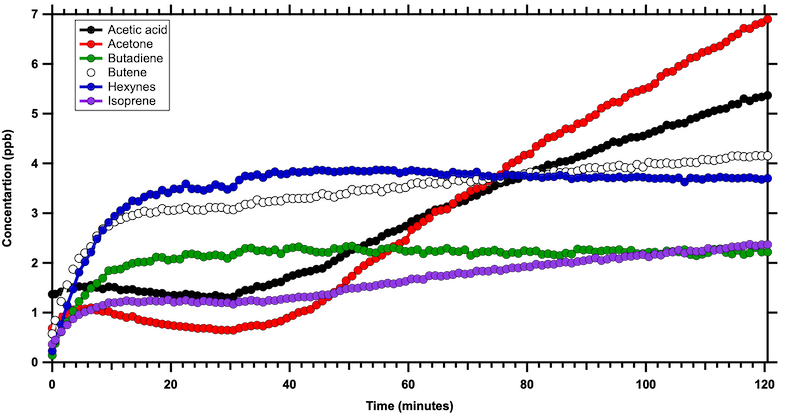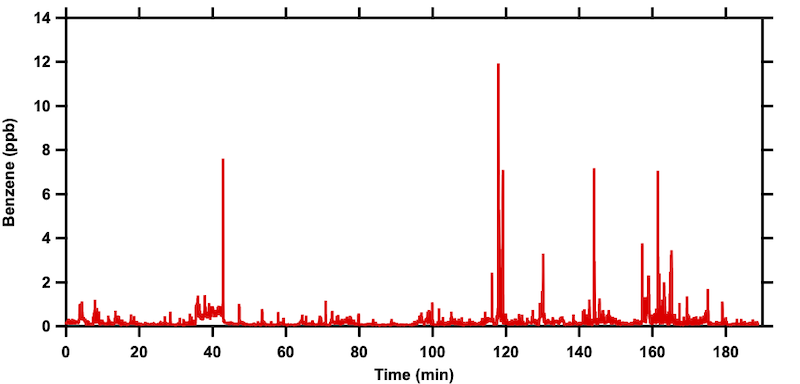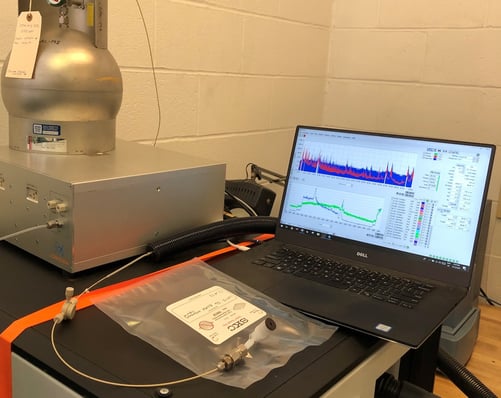RJ Lee Group 10 min read
Advanced Technology: Proton Transfer Reaction Mass Spectrometer (PTR-MS)
Contributors
RJ Lee Group
Subscribe to our newsletter
Mass spectrometry is a critical component of many analytical techniques used for the identification and quantification of organic compounds in a wide variety of sample matrices from both environmental and industrial sources. The foundational principle is that individual chemical compounds have a known molecular weight that can be used to identify and quantify them. The physics behind the analytical methods are beyond the scope of this article, but it is typically necessary to add a charge (ionize) to each molecule to allow for mass separation, detection, and quantification using a mass spectrometer. Analysis using a mass spectrometer, commonly results in the fragmentation of larger molecules into smaller ones, complicating the interpretation, as the pattern of the fragmented masses needs to be identified and used for the identification and quantification of the original larger molecules. The delicate nature of these analytical operations requires that most mass spectrometers can only operate within the confines of a laboratory, analyzing discrete samples introduced into these instruments.
The advent of PTR-MS technology has addressed several of the limitations of laboratory benchtop units described above. PTR-MS is a “soft” ionization mass spectrometer. Charge is added to each molecule using water, oxygen, or nitrogen oxide molecules which suppress the fragmentation of the compounds, allowing for a more robust analysis of the mass spectrum. PTR-MS is particularly adept at the identification and measurement of volatile organic compounds (VOCs) in air. It can provide real-time, continuous measurement of multiple volatile organic compounds (VOCs) at ultra-trace levels, i.e., in the parts per trillion (ppt) and low parts per billion (ppb) range. A truck-mounted solution also gives the instrument mobility for environmental monitoring and sourcing investigations.
The PTR-MS has been used in many peer-reviewed studies for the detection of VOCs. Studies include ambient measurements for the investigation of the air quality of urban and suburban areas.1,2 The information that the PTR-MS provides can be used in air quality source apportionment studies in order to gain insight into the sources of different air toxins such as toluene, xylene, and benzene; biogenic compounds emitted by vegetation, such as isoprene, monoterpenes, and sesquiterpenes; and other compounds such as acetaldehyde, formaldehyde, and acetone.3,4 Other studies have used the PTR-MS for the detection of emissions from different sources, such as biomass burning5,6, cooking activities7, and diesel exhaust8. Other applications include the testing of emissions from materials, investigation of indoor air quality, and vapor intrusion studies9-12. Most recently the device was used for the breath analysis and identification of biomarkers of Covid-19 patients13. The ability of real-time detection of VOCs makes the PTR-MS the ideal instrument for these applications.

Case study 1: Laboratory testing – headspace sampling
Due to its high sensitivity and low time resolution, the PTR-MS is the perfect tool for headspace sampling. RJ Lee Group has implemented the PTR-MS in several headspace projects for the detection of emissions from carbon black, canned food products, as well as products such as gloves and face masks. In a previous study, RJ Lee Group investigated the compounds emitted by a medical device. The device was placed in a testing Tedlar bag, which was filled with clean air. The PTRMS was used to monitor the VOC concentration inside the bag. After the device was turned on, the concentration of 6 compounds increased. After two hours of testing, compounds such as butadiene and hexanes had reached a plateau at a concentration lower than 5 ppb (Figure 1). The concentration of acetone, acetic acid, isoprene, and butene continued increasing during the whole testing period.

Case study 2: Field Measurements mobile applications
The PTR-MS can also be used to study the air quality of an area. The combination of the PTRMS with RJ Lee Group’s mobile laboratory can allow for temporal and spatial resolution air quality measurements. Our scientists have conducted numerous fenceline monitoring and community air quality monitoring projects. In a recent study, we measured the ambient concentration of benzene in the greater area of Philadelphia. We were able to identify the higher emitters and investigate their impact in the neighboring communities (Figures 2 and 3).


References
1. De Gouw, J. A., Welsh-Bon, D., Warneke, C., Kuster, W. C., Alexander, L., Baker, A. K., Beyersdorf, A. J., Blake, D. R., Canagaratna, M., Celada, A. T., et al.: Emission and chemistry of organic carbon in the gas and aerosol phase at a sub-urban site near Mexico City in March 2006 during the MILAGRO study. Atmos. Chem. Phys.,9, 3425-3442, 2009.
2. Shah, R. U., Coggon, M. M., Gkatzelis, G. I., McDonald, B. C., Tasoglou, A., Heinz Huber, Jessica Gilman, J., Warneke, C., Robinson, A. L. Presto, A.: Observational evidence of the importance of secondary organic aerosol of volatile chemical products, Environ. Sci. Technol.,54 (2), 714-725, 2020.
3. Kaltsonoudis, C., Kostenidou, E., Florou, K., Psichoudaki, M., Pandis, S. N.: Temporal variability and sources of VOCs in urban areas of the eastern Mediterranean, Atmos. Chem. Phys., 16, 14825–14842, 2016.
4. Crippa, M., Canonaco, F., Slowik, J. G., El Haddad, I., DeCarlo, P. F., Mohr, C., Heringa, M. F., Chirico, R., Marchand, N., Temime-Roussel, B., Abidi, E., Poulain, L., Wiedensohler, A., Baltensperger, U., and Prévôt, A. S. H.: Primary and secondary organic aerosol origin by combined gas-particle phase source apportionment, Atmos. Chem. Phys., 13, 8411–8426, 2013.
5. Tasoglou, A., Saliba, G., Subramanian, R., Pandis, S. N.: Absorption of Chemically Aged Biomass Burning Carbonaceous Aerosol, J. Aerosol. Sci., 113, 141–52, 2017.
6. Gilman, J. B., Lerner, B. M., Kuster, W. C., Golden, P. D., Warneke, C., Veres, P. R., Roberts, J. M., de Gouw, J. A., Burling, I. R., and Yokelson, R. J.: Biomass burning emissions and potential air quality impacts of volatile organic compounds and other trace gases from fuels common in the US, Atmos. Chem. Phys., 15, 13915–13938, 2015.
7. Klein, F., Platt, S. M., Farren, N. J., Detournay, A., Bruns, E. A., Bozzetti, C., Daellenbach, K. R., Kilic, D., Kumar, N. K., Pieber, S. M., et al.: Characterization of gas-phase organics using proton transfer reaction time-of-flight mass spectrometry: cooking emissions, Environ. Sci. Technol., 50, 1243-1250, 2016.
8. Inomata, S., Tanimoto, H., Fujitani, Y., Sekimoto, K., Sato, K., Fushimi, A., Yamada, H., Hori, S., Kumazawa, Y., Shimono, A., et al.: On-line measurements of gaseous nitro-organic compounds in diesel vehicle exhaust by proton-transfer-reaction mass spectrometry, Atmos. Environ., 73, 195-203, 2013.
9. Sears, J.; Rogers, T.; McCoskey, J.; Lockrem, L.; Watts, H.; Pingel, L.; Conca, J. Proton Transfer Reaction Mass Spectrometry as a Real-Time Method for Continuous Soil Organic Vapor Detection. In Continuous Soil Gas Measurements: Worst Case Risk Parameters; ASTM International: 100 Barr Harbor Drive, PO Box C700, West Conshohocken, PA 19428-2959, 32-44, 2013.
10.Peinado, I., Marco, M., Franco, B., Scampicchio, M..: Hyphenation of Proton Transfer Reaction Mass Spectrometry with Thermal Analysis (TG/TR-MS) for Monitoring the Thermal Degradation of Retinyl Acetate, Rapid Commun. Mass Spectrom. 32, 57-62, 2018.
11. Rosales, C. M. F., Jiang, J., Lahib, A., Bottorff, B. P., Reidy, E. K., Kumar, V., Tasoglou, A., Huber, H., Dusanter, S., Tomas, A., Boor, B. E., Stevens, P. S.: Chemistry and human exposure implications of secondary organic aerosol production from indoor terpene ozonolysis, Sci. Adv., 8, 2022.
12. Wu, T., Tasoglou, A., Huber, H., Stevens, P. S., Boor, B. E.: Influence of Mechanical Ventilation Systems and Human Occupancy on Time-Resolved Source Rates of Volatile Skin Oil Ozonolysis Products in a LEED-Certified Office Building, Environ. Sci. Technol. Lett., 24, 16477-16488, 2021.
13. Liangou, A., Tasoglou, A., Heinz J. H. J., Wistrom, C., Brody, K., Menon, P. G., Bebekoski, T., Menschel, K., Davidson-Fiedler, M., DeMarco, K., Salphale, H. Wistrom, J., Wistrom, S., Lee, R. J.: A novel method for the identification of COVID-19 biomarkers in human breath using the PTR-ToF-MS, EclinicalMedicine, 42, 101207, 2021.
APPLICABLE RJLG SERVICES
Emission testing of materials and commercial products using the TGA-PTR-MS
Fenceline monitoring, Industrial emissions evaluations
Environmental test chamber studies
Indoor air quality testing (IAQ)
Vapor intrusion studies
Source identification
Product off-gassing
Infection detection


